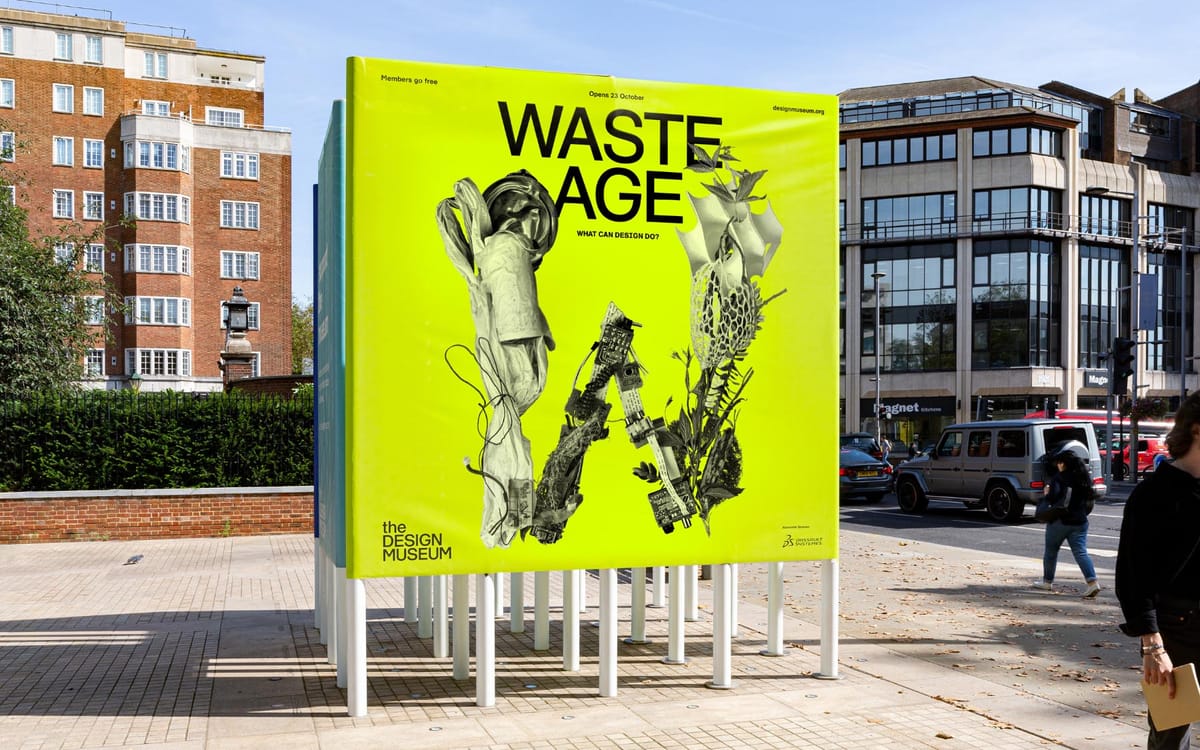
Waste Age, an exhibition capturing the devastating impact of waste and showcasing visionary designers who are reimagining our relationship with waste, exhibited at London’s Design Museum from October 2021 to February 2022. Opening 3 months before the UN Climate Change Conference (COP26), the exhibition offered a necessary ‘wake-up call’ for the design industry, providing both designers and the general public an opportunity to reflect on the throwaway culture they helped to create, and to consider new design-led innovations to a waste free future. We believe this is the first environmental audit conducted on an exhibition in the UK.
As part of the exhibition design process, URGE Collective’s Alexie Sommer, Ralf Waterfield and Sophie Thomas conducted an environmental audit of the exhibition to calculate its impact, as well as to provide the Museum with benchmarking data and best practice processes for future exhibitions. Sophie Thomas was invited to join the advisory panel of leading experts, to guide the exhibition's development and challenge the Museum’s established methods. On the strength of this role, Sophie exhibited the work Re-materialise: a library of possibilities as part of the exhibition.

Measuring
The environmental audit was based on a Life Cycle Analysis (LCA) approach. URGE worked with the museum’s curatorial, design, facilities and production teams to understand the environmental impact of the building and the exhibition design, and to guide design decisions that would reduce the exhibition’s impact.
URGE created an Impact Model to monitor the three life cycle stages – pre-exhibition, live exhibition, and post exhibition – and to highlight the technical source of impacts. These include the manufacture of materials, renewability of energy sources and the weight and origin of exhibits. Beyond these were non-technical levers that can be controlled or influenced by the Museum, such as brief criteria and travel recommendations. The Impact Model was informed by stakeholder interviews, desk research, design reviews, observation of the production process, email trackers, a review of the Museum’s facilities procurement, resource consumption and waste generation, and an extensive data gathering exercise. This process enabled a detailed data inventory relating to transport, energy, collateral, exhibits, commissions, food, and more to give a fuller picture of the impact of Waste Age.
Developing
“The interviews, design reviews and conversations provided a learning experience that helped everyone involved understand how changes they make could have knock-on effects,” (Alexie Sommer, URGE)
URGE supported Waste Age’s 2D designers – SPIN – to reduce the impact of their digital carbon, and their print outputs: for example, by using a print gun for signage rather than single-use vinyl. URGE also worked closely with the exhibition’s 3D designers – Material Cultures – to develop lower-impact structures for the exhibition, using these key approaches:
- Reusing elements of previous exhibitions: a central wall and plinths from Electronic were repurposed for Waste Age
- Constructing rooms from biodegradable materials: wool, locally sourced clay, and cross-laminated timber also have low embodied carbon
- Designing structures to be deconstructed and fully reused: a wall of unfired Adobe bricks with no fittings was designed to be disassembled and returned for reuse.

Knowledge Sharing
URGE used data analysis to produce a pre-exhibition audit summary, measured in carbon tons, for display within the exhibition. This helped the Design Museum convey the exhibition's environmental impact clearly, sparking discussions among designers, staff, partners, and visitors on reducing energy, waste, and associated impacts.
Total Exhibition Impact
Approximately 28 tons CO2e – 30% of which is in the build & 50% is in the Ibrahim Mahama installation, Fadama40.
Building Energy
Energy supply is the most important step to reducing emissions. If the Design Museum used the national average electricity, the impact of the exhibition would be about 185 tons CO2e. The museum’s use of renewable energy cut the total impact by about 85%.
Exhibits
The objects weigh roughly 2.5 tonnes, with the Fadama 40 object alone accounting for 2 tonnes, and the average distance they travelled is roughly 1,2500km (many are from London) thus the logistics footprint, excluding Fadama 40, is less than 20kg CO2e (or 0.06% of the total footprint). The showpiece installation from Ibrahim Mahama adds another 5 tonnes CO2e to the count.
Exhibition build
The highest single impact in the construction comes from the screws which hold the reusable cassette system together. Using 4,800 standard stainless steel decking screws has an impact of 1.9 tons CO2e – roughly 7% of the total exhibition footprint. Using a timber frame system over a standard aluminium exhibition frame system saved 1.5 tons CO2e, reducing the impact by about two thirds.
Using unfired bricks instead of fired bricks saved 6 tons CO2e, the second most significant saving after switching to renewable electricity.
Reuse of existing materials/build
- Partition wall from a Stanley Kubrick 2019 exhibition
- Silicate bricks from previous exhibition
Re-use Post-exhibition
The second life of materials was key to keeping Waste Age’s carbon footprint low. The Design Museum managed to secure new homes for the majority of the exhibition elements:
- All wood wool and timber donated to New Road Group (construction company)
- 800 fired bricks donated to New Road Group
- Perspex cases: most will tour with the exhibition to Paris, some given to RCA students
- 250 fired bricks, 10 silicate blocks and 10 adobe bricks donated to Ella Doran
- All felt donated to Phoebe English for a collection
Design decisions about waste
- Floor not covered
- Print gun used instead of vinyl for graphics (from a waste concern rather than carbon impact)
Digital Communication
- Up to 3% of the total footprint is associated with digital communication:
- Emails: approximately 11,000 emails and 11GB of data have been shared, which equates to around
- 1 ton CO2e.
- Video calls: approximately 750 person hours were spent on video calls. The impact of this is less than 0.15% of the total footprint.

